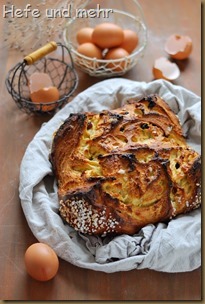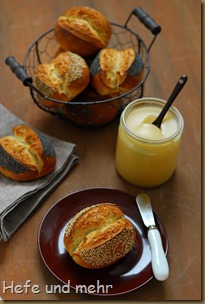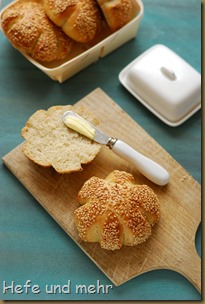 So here is now the promised Spelt bread. I know that many of the readers of this blog like to bake with spelt, but baking with spelt flour is a little bit more challenging then baking with wheat flour, so the recipe comes relatively late in my bread baking course.
So here is now the promised Spelt bread. I know that many of the readers of this blog like to bake with spelt, but baking with spelt flour is a little bit more challenging then baking with wheat flour, so the recipe comes relatively late in my bread baking course.
Spelt is closely realted to wheat. But there are two thing to keep in mind when working with spelt. Flour made from spelt contains a different composition of gluten proteins which finally results in a more fragile gluten network. This makes it easy to “over knead” spelt dough, meaning that the dough is kneaded longer then it takes to obtain full gluten development which ends in breaking down the gluten network once again. Due to this fact I prefer to knead spelt dough by hand which gives me a better control then kneading with the kitchen machine. If kneading with the machine it is important to keep a close eye on the dough and testing the gluten development by the window pane test. Intervall kneading (kneading shortly with breaks in between) can be handy as well. Continue reading


 Last weekeend I realized how near Eastern is when my mom told me on the phone about her plans of dyeing eggs with her kids at school. And so I changed my plans for the bread baking course and developed a sweet recipe perfect for the Easter Breakfast. It is a sweet bread called which is made with the biga preferement. The subtle acidity of it helps to strengthen the gluten network. For a tender crumb the dough contains cream, egg yolk and some butter. By replacing the butter with cream the dough can rise in the fridge if needed.
Last weekeend I realized how near Eastern is when my mom told me on the phone about her plans of dyeing eggs with her kids at school. And so I changed my plans for the bread baking course and developed a sweet recipe perfect for the Easter Breakfast. It is a sweet bread called which is made with the biga preferement. The subtle acidity of it helps to strengthen the gluten network. For a tender crumb the dough contains cream, egg yolk and some butter. By replacing the butter with cream the dough can rise in the fridge if needed. I mentioned already once or twice that I like to at
I mentioned already once or twice that I like to at 
 To me, the basic of good breakfast is a good roll. And so we are baking rolls in part three of our little bread baking course. These rolls are looking more complicated then they. For shaping we will use the same method then for the bread we baked last time. And already after 15 minutes the rolls are deeply cut, which is much easier than cutting a fully proofed roll. The cut is carefully laid together and will open beautiful during baking.
To me, the basic of good breakfast is a good roll. And so we are baking rolls in part three of our little bread baking course. These rolls are looking more complicated then they. For shaping we will use the same method then for the bread we baked last time. And already after 15 minutes the rolls are deeply cut, which is much easier than cutting a fully proofed roll. The cut is carefully laid together and will open beautiful during baking. I got a lot of positive feedback to my idea of making a small virtual bread baking course. I’m very happy about it and will start to post more beginner recipes on the blog in the next weeks. And if you have questions, ideas or wishes: Please tell me! I will do my best to include it.
I got a lot of positive feedback to my idea of making a small virtual bread baking course. I’m very happy about it and will start to post more beginner recipes on the blog in the next weeks. And if you have questions, ideas or wishes: Please tell me! I will do my best to include it.

 How to start baking bread? I remember that I started with searching for a recipe and just simple following the instruction. I can’t tell you anymore which recipe it was (it was before I started blogging) but I knew that it was far away from being perfect. But I already cached the bread baking virus.
How to start baking bread? I remember that I started with searching for a recipe and just simple following the instruction. I can’t tell you anymore which recipe it was (it was before I started blogging) but I knew that it was far away from being perfect. But I already cached the bread baking virus.